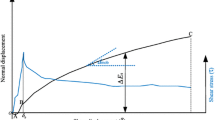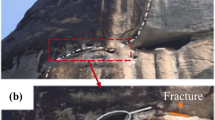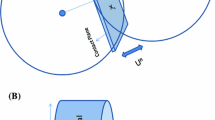Abstract
Accurately predicting the hydromechanical behaviour of rock fractures is challenging due to the significant influence of shear-induced fracture geometries. This work proposes an improved shear-flow model that accurately estimates nonlinear fluid flow behaviour as well as shear mechanical behaviour. To predict shear mechanical behaviour, the model employs a modified multi-scale roughness shear constitutive model that accounts for water moisture effects. In addition, the evolution of the fracture void structure subjected to shearing is computed by a fracture void space model. A Forchheimer equation-based model incorporating fracture surface roughness and fluid flow tortuosity is introduced to model fluid flow nonlinearity. Laboratory shear-flow tests are conducted under constant normal stresses of 1, 1.5, and 2 MPa, utilising a newly developed shear-flow testing apparatus. The predicted shear mechanical and hydraulic behaviours of the fracture agree well with the experimental results, with \({\tilde{\sigma }}_{ave}\) of 11.6% for shear strength, NOF of 0.25 for shear dilation, and NOF of 0.14 for fluid flow rate. The proposed model improves the understanding and prediction accuracy of hydromechanical behaviours of fractures in engineering and geological applications.
Highlights
-
A multi-scale shear model using adhesion and abrasion theories is introduced.
-
The effect of water moisture on shear behaviours is considered.
-
The surface roughness and flow tortuosity are considered in the flow model.
-
The evolution of fracture geometry is computed by the fracture void space model.


















Similar content being viewed by others
Data availability
The datasets used and analysed during the current study are available from the corresponding author on reasonable request.
Abbreviations
- 2D,3D:
-
Two-dimensional, three-dimensional
- 3DEC:
-
Three-dimensional distinct element code
- A, B :
-
The linear and nonlinear coefficients of the Forchheimer equation
- \({a}_{D}\), \({b}_{D}\) :
-
Dimensionless linear and nonlinear coefficients of the Forchheimer equation
- \({a}_{o}\) :
-
Laboratory-scale unevenness asperity inclination angle
- BB model:
-
Barton–Bandis shear constitutive model
- CCD:
-
Charge-coupled device
- CNL:
-
Under constant normal loading conditions
- \({d}_{n}\), \({d}_{s}\) :
-
Normal displacements due to the normal and shear effects
- \({e}_{o}\) :
-
Initial mechanical aperture
- \({e}_{h}\) :
-
Hydraulic aperture
- \({e}_{m}\) :
-
Mechanical aperture
- \(\langle {e}_{m}\rangle\) :
-
Mean value of fracture aperture
- \({e}_{m({x}_{i},{y}_{j})}\) :
-
Local mechanical aperture at (\({x}_{i}\), \({y}_{j}\))
- i :
-
Laboratory-scale waviness asperity inclination angle
- JRC:
-
Joint roughness coefficient
- JRCmob:
-
Mobilised JRC
- \({K}_{ad}\) :
-
A dimensionless wear coefficient
- \({K}_{s}\) :
-
Shear stiffness
- \({k}_{1}\) :
-
Geometry factor
- K :
-
Softening coefficient for a given shear test
- L :
-
Fracture length
- M :
-
Damage coefficient
- NOF:
-
Normalized Objective Function
- \({N}_{x},\) \({N}_{y}\) :
-
The number of points along the x and y directions
- ∇P:
-
Hydraulic pressure gradient
- Q :
-
Flow rate
- RMSE:
-
Root mean square error
- \({R}_{s}\) :
-
Surface roughness coefficient
- Re:
-
The Reynolds number
- \({T}_{s}\) :
-
Joint interface roughness
- UCS :
-
Uniaxial compressive strengths
- \({u}_{peak}\) :
-
Peak shear displacement
- \({u}_{s}\) :
-
Shear displacement
- \({u}_{s}^{e}\) :
-
The shear displacement for the onset of the total dilation
- w :
-
Fracture width
- \({Z}_{2}\) :
-
The root-mean-square of the 2D surface profile
- \(\gamma\) :
-
The slope of linear regression between the
- \(\Delta {u}_{s}\) :
-
Incremental shear displacement
- \(\Delta {d}_{s}\) :
-
The corresponding incremental normal displacement
- \(\vartheta\) :
-
Fluid tortuosity
- \({\theta }^{*}\) :
-
Surface roughness parameter based on local apparent dip angle of asperities
- \({\lambda }_{p},{\lambda }_{s}\) :
-
Laboratory-scale waviness and unevenness asperity wavelengths
- \(\mu\) :
-
Dynamic viscosity of fluid
- \({\mu }_{{p}_{mob}}\) :
-
Mobilised shear-off component
- \({\mu }_{pp},{\mu }_{ps}\) :
-
Shear-off components corresponding to laboratory-scale waviness and unevenness
- \(\xi\) :
-
Peak asperity height
- \(\xi /{e}_{h}\) :
-
Relative roughness
- \({\xi }_{{x}_{i},{y}_{j}}\), \({\xi }_{{x}_{i+1},{y}_{j}},{\xi }_{{x}_{i},{y}_{j+1}}\) :
-
Asperity height at point (\({x}_{i},{y}_{j}\)), (\({x}_{i+1},{y}_{j}\)) and (\({x}_{i},{y}_{j+1}\))
- \(\rho\) :
-
Fluid density
- \({\sigma }_{n}\) :
-
Normal stress (MPa)
- \({\sigma }_{T}\) :
-
Transitional normal stress
- \({\sigma }_{ape}\) :
-
Standard deviations of mechanical aperture
- \({\tilde{\sigma }}_{ave}\) :
-
Average error
- \(\tau\) :
-
Shear stress (MPa)
- \(\tau \left(k\right)\), \(\tau (k-1):\) :
-
Shear stress at the current and previous time-step
- \({\chi }_{measure}\), \({\chi }_{predict}:\) :
-
Experimental and predicted values
- \({\overline{\chi }}_{measure}\) :
-
The mean value of the experimental data
- \({\psi }_{mob}\) :
-
Mobilised dilation angle
References
Barton N, Choubey V (1977) The shear strength of rock joints in theory and practice. Rock Mech 10:1–54. https://doi.org/10.1007/BF01261801
Belem T, Homand-Etienne F, Souley M (2000) Quantitative parameters for rock joint surface roughness. Rock Mech Rock Eng 33:217–242
Chen Y, Zhou J, Hu S et al (2015) Evaluation of Forchheimer equation coefficients for non-Darcy flow in deformable rough-walled fractures. J Hydrol 529:993–1006. https://doi.org/10.1016/j.jhydrol.2015.09.021
Chen Y, Liang W, Lian H et al (2017) Experimental study on the effect of fracture geometric characteristics on the permeability in deformable rough-walled fractures. Int J Rock Mech Min Sci 98:121–140. https://doi.org/10.1016/j.ijrmms.2017.07.003
De La Vaissière R, Armand G, Talandier J (2015) Gas and water flow in an excavation-induced fracture network around an underground drift: A case study for a radioactive waste repository in clay rock. J Hydrol 521:141–156. https://doi.org/10.1016/j.jhydrol.2014.11.067
Esaki T, Du S, Mitani Y et al (1999) Development of a shear-flow test apparatus and determination of coupled properties for a single rock joint. Int J Rock Mech Min Sci 36:641–650. https://doi.org/10.1016/S0148-9062(99)00044-3
Gao M, Zhang C, Oh J (2023a) Assessments of the effects of various fracture surface morphology on single fracture flow: A review. Int J Min Sci Tech. https://doi.org/10.1016/j.ijmst.2022.07.005
Gao M, Zhang C, Oh J (2023b) A multi-scale roughness rock joint model using adhesion and abrasion wear theories. Int J Rock Mech Min Sci (Minor revision).
Gerrard C (1986) Shear failure of rock joints: Appropriate constraints for empirical relations. Int J Rock Mech Min Sci Geomech Abstr 23:421–429. https://doi.org/10.1016/0148-9062(86)92307-7
Grasselli G, Egger P (2003) Constitutive law for the shear strength of rock joints based on three-dimensional surface parameters. Int J Rock Mech Min Sci 40:25–40. https://doi.org/10.1016/S1365-1609(02)00101-6
Heinze T, Frank S, Wohnlich S (2021) FSAT – A fracture surface analysis toolbox in MATLAB to compare 2D and 3D surface measures. Comput Geotech 132:103997. https://doi.org/10.1016/j.compgeo.2020.103997
Javadi M, Sharifzadeh M, Shahriar K et al (2014) Critical Reynolds number for nonlinear flow through rough-walled fractures: The role of shear processes. Water Resour Res 50:1789–1804. https://doi.org/10.1002/2013WR014610
Leong E, Randolph M (1992) A model for rock interfacial behaviour. Rock Mech Rock Eng 25:187–206
Li B, Jiang Y, Koyama T et al (2008) Experimental study of the hydro-mechanical behavior of rock joints using a parallel-plate model containing contact areas and artificial fractures. Int J Rock Mech Min Sci 45:362–375. https://doi.org/10.1016/j.ijrmms.2007.06.004
Li Y, Oh J, Mitra R et al (2016) A constitutive model for a laboratory rock joint with multi-scale asperity degradation. Comput Geotech 72:143–151
Li B, Li Y, Zhao Z et al (2019) A mechanical-hydraulic-solute transport model for rough-walled rock fractures subjected to shear under constant normal stiffness conditions. J Hydrol 579:124153. https://doi.org/10.1016/j.jhydrol.2019.124153
Li B, Ye X, Dou Z et al (2020a) Shear Strength of Rock Fractures Under Dry, Surface Wet and Saturated Conditions. Rock Mech Rock Eng 53:2605–2622. https://doi.org/10.1007/s00603-020-02061-y
Li Y, Ca T, Li D et al (2020b) Anew shear strength criterion of three-dimensional rock joints. Rock Mech Rock Eng 53:1477–1483. https://doi.org/10.1007/s00603-019-01976-5
Liu R, Wang Y, Li B et al (2022) Linear and nonlinear fluid flow responses of connected fractures subject to shearing under constant normal load and constant normal stiffness boundary conditions. Comput Geotech 141:104517. https://doi.org/10.1016/j.compgeo.2021.104517
Louis C (1969) A study of groundwater flow in jointed rock and its influence on the stability of rock masses. Rock Mech Res Rep
Oh J, Cording EJ, Moon T (2015) A joint shear model incorporating small-scale and large-scale irregularities. Int J Rock Mech Min Sci 76:78–87. https://doi.org/10.1016/j.ijrmms.2015.02.011
Olsson R, Barton N (2001) An improved model for hydromechanical coupling during shearing of rock joints. Int J Rock Mech Min Sci 38:317–329. https://doi.org/10.1016/S1365-1609(00)00079-4
Qian J, Zhan H, Chen Z et al (2011) Experimental study of solute transport under non-Darcian flow in a single fracture. J Hydrol 399:246–254. https://doi.org/10.1016/j.jhydrol.2011.01.003
Rong G, Yang J, Cheng L et al (2016) Laboratory investigation of nonlinear flow characteristics in rough fractures during shear process. J Hydrol 541:1385–1394. https://doi.org/10.1016/j.jhydrol.2016.08.043
Rong G, Hou D, Yang J et al (2017) Experimental study of flow characteristics in non-mated rock fractures considering 3D definition of fracture surfaces. Eng Geol 220:152–163. https://doi.org/10.1016/j.enggeo.2017.02.005
Rong G, Yang J, Cheng L et al (2018) A Forchheimer equation-based flow model for fluid flow through rock fracture during shear. Rock Mech and Rock Eng 51:2777–2790. https://doi.org/10.1007/s00603-018-1497-y
Rong G, Tan J, Zhan H et al (2020) Quantitative evaluation of fracture geometry influence on nonlinear flow in a single rock fracture. J Hydrol 589:125162. https://doi.org/10.1016/j.jhydrol.2020.125162
Shen J, Qin G, Gu X et al (2022) Effects of seasonal hydrological regulation of cascade dams on the functional diversity of zooplankton: Implications for the management of massive reservoirs and dams. J Hydrol 610:127825. https://doi.org/10.1016/j.jhydrol.2022.127825
Tse R, Cruden DM (1979) Estimating joint roughness coefficients. Int J Rock Mech Min Sci Geomech Abstr 16:303–307. https://doi.org/10.1016/0148-9062(79)90241-9
Wang C, Jiang Y, Liu R et al (2020) Experimental study of the nonlinear flow characteristics of fluid in 3D rough-walled fractures during shear process. Rock Mech Rock Eng. https://doi.org/10.1007/s00603-020-02068-5
Wang C, Liu R, Jiang Y et al (2022) Effect of shear-induced contact area and aperture variations on nonlinear flow behaviors in fractal rock fractures. J Rock Mech Geotech Eng. https://doi.org/10.1016/j.jrmge.2022.04.014
Xiao W, Xia C, Wei W et al (2013) Combined effect of tortuosity and surface roughness on estimation of flow rate through a single rough joint. J Geophys Eng. https://doi.org/10.1088/1742-2132/10/4/045015
Xie LZ, Gao C, Ren L et al (2015) Numerical investigation of geometrical and hydraulic properties in a single rock fracture during shear displacement with the Navier-Stokes equations. Environ Earth Sci 73:7061–7074. https://doi.org/10.1007/s12665-015-4256-3
Xiong X, Li B, Jiang Y et al (2011) Experimental and numerical study of the geometrical and hydraulic characteristics of a single rock fracture during shear. Int J Rock Mech Min Sci 48:1292–1302. https://doi.org/10.1016/j.ijrmms.2011.09.009
Yeo W (2001) Effect of contact obstacles on fluid flow in rock fractures. Geosci J 5:139–143
Zhang Z, Nemcik J (2013) Fluid flow regimes and nonlinear flow characteristics in deformable rock fractures. J Hydrol 477:139–151. https://doi.org/10.1016/j.jhydrol.2012.11.024
Zhang X, Jiang Q, Chen N et al (2016) Laboratory investigation on shear behavior of rock joints and a new peak shear strength criterion. Rock Mech Rock Eng 49:3495–3512. https://doi.org/10.1007/s00603-016-1012-2
Zhang X, Jiang Q, Kulatilake PHSW et al (2019) Influence of asperity morphology on failure characteristics and shear strength properties of rock joints under direct shear tests. Int J Geomech 19:04018196. https://doi.org/10.1061/(ASCE)GM.1943-5622.0001347
Zhou J, Hu S, Chen Y et al (2016) The friction factor in the Forchheimer equation for rock fractures. Rock Mech Rock Eng 49:3055–3068. https://doi.org/10.1007/s00603-016-0960-x
Zimmerman RW, Bodvarsson GS (1996) Hydraulic conductivity of rock fractures. Transp Porous Media 23:1–30. https://doi.org/10.1007/BF00145263
Funding
No external funding was used.
Author information
Authors and Affiliations
Corresponding author
Ethics declarations
Conflict of interest
The authors declare that they have no conflict of interest.
Additional information
Publisher's Note
Springer Nature remains neutral with regard to jurisdictional claims in published maps and institutional affiliations.
Rights and permissions
Springer Nature or its licensor (e.g. a society or other partner) holds exclusive rights to this article under a publishing agreement with the author(s) or other rightsholder(s); author self-archiving of the accepted manuscript version of this article is solely governed by the terms of such publishing agreement and applicable law.
About this article
Cite this article
Gao, M., Zhu, X., Zhang, C. et al. A Hydromechanical Model for a Single Rock Fracture Subjected to Shearing. Rock Mech Rock Eng (2024). https://doi.org/10.1007/s00603-023-03588-6
Received:
Accepted:
Published:
DOI: https://doi.org/10.1007/s00603-023-03588-6




